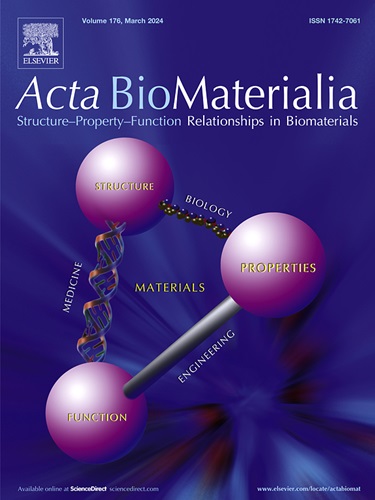一种联合递送多西紫杉醇和ROR1 siRNA的前药纳米装置用于增强三阴性乳腺癌治疗。
IF 9.4
1区 医学
Q1 ENGINEERING, BIOMEDICAL
引用次数: 0
摘要
三阴性乳腺癌(TNBC)由于其高复发和转移率一直是一个临床挑战。化疗仍然是手术消融后TNBC的主要治疗方法,但它缺乏靶向特异性,在正常组织中会产生副作用。受体酪氨酸激酶样孤儿受体1 (ROR1)在TNBC细胞中显著表达,靶向ROR1的小干扰RNA (siRNA)可有效抑制ROR1基因表达,从而抑制增殖和转移。然而,ROR1 siRNA的临床应用受到清除易感性和内体逃逸困难的限制。本研究构建了多西紫杉醇(docetaxel, DTX)前体药物纳米颗粒BBRM,用于递送ROR1 siRNA。BBRM可被肿瘤细胞有效内化,内体逃逸释放DTX和ROR1 siRNA。在4T1荷瘤小鼠中,BBRM可靶向给药至肿瘤和肺组织,具有良好的生物安全性,抑瘤率达74.1%,可抑制肺转移。BBRM通过化疗与RNA干扰治疗的结合,成功地将化疗药物与siRNA联合递送,提高了三阴性乳腺癌的治疗效果,为临床转化提供了一种有希望的策略。意义声明:化疗仍是三阴性乳腺癌(TNBC)手术消融后的主要治疗方法,但其副作用无靶向能力。ROR1在TNBC细胞中显著表达,RNA干扰ROR1可抑制ROR1基因表达,抑制肿瘤增殖。然而,作为寡核苷酸,ROR1 siRNA的作用受到清除易感性和内体逃逸困难的限制。在这项工作中,我们设计了一种基于靶向ROR1的多西紫杉醇(DTX)前药的纳米器件,用于TNBC的协同治疗。我们构建了一个纳米颗粒(BBRM)来共同递送DTX和ROR1 siRNA。BBRM可被肿瘤细胞和内体逃逸有效内化。ROR1 siRNA下调ROR1蛋白表达,提高抗增殖和抗转移作用。此外,BBRM逆转了免疫抑制的肿瘤微环境,从而提高了乳腺癌的治疗效果。这是一项开创性的研究,通过共同递送DTX和ROR1 siRNA来协同化疗基因治疗TNBC。本文章由计算机程序翻译,如有差异,请以英文原文为准。

A prodrug nanodevice co-delivering docetaxel and ROR1 siRNA for enhanced triple negative breast cancer therapy
Triple-negative breast cancer (TNBC) has been a clinical challenge due to its high recurrence and metastasis rates. Chemotherapy remains the primary treatment for TNBC after surgery ablation, but it lacks targeted specificity and causes side effects in normal tissues. Receptor tyrosine kinase-like orphan receptor 1 (ROR1) is significantly expressed in TNBC cells, and small interference RNA (siRNA) targeting ROR1 can effectively suppress ROR1 gene expression, thereby inhibiting proliferation and metastasis. However, clinical application of ROR1 siRNA is limited by susceptibility to clearance and difficulty in endosomal escape. In this study, the docetaxel (DTX) prodrug nanoparticle BBRM delivering ROR1 siRNA was constructed. The BBRM could be effectively internalized by tumor cells and endosomal escape to release DTX and ROR1 siRNA. In 4T1 tumor-bearing mice, BBRM could be targeting delivered to tumor and lung tissues, with good biosafety, achieving a tumor inhibition rate of 74.1 % and inhibiting lung metastasis. By integrating chemotherapy and RNA interference therapy, BBRM successfully co-delivered chemotherapeutic agents and siRNA to improve the therapeutic efficacy of triple-negative breast cancer and provided a promising strategy for clinical transformation.
Statement of significance
Chemotherapy is still the primary treatment for triple-negative breast cancer (TNBC) after surgery ablation, but it causes side effects without targeting capacity. ROR1 is significantly expressed in TNBC cells, and RNA interference for ROR1 can suppress ROR1 gene expression to inhibit tumor proliferation. However, as oligonucleotides, effect of ROR1 siRNA is limited by susceptibility to clearance and difficulty in endosomal escape. In this work, we designed a nanodevice based on a docetaxel (DTX) prodrug that targets ROR1 for the synergistic therapy of TNBC. We constructed a nanoparticle (BBRM) for co-delivery of the DTX and ROR1 siRNA. The BBRM could be effectively internalized by tumor cells and endosomal escape. The ROR1 siRNA downregulated ROR1 protein expression and improved the anti-proliferative and anti-metastatic effects. In addition, BBRM reversed the immunosuppressive tumor microenvironment, thus improving breast cancer therapeutic efficacy. It was a pioneering investigation in synergistic chemo-gene therapy by co-delivering DTX and ROR1 siRNA for TNBC treatment.
求助全文
通过发布文献求助,成功后即可免费获取论文全文。
去求助
来源期刊

Acta Biomaterialia
工程技术-材料科学:生物材料
CiteScore
16.80
自引率
3.10%
发文量
776
审稿时长
30 days
期刊介绍:
Acta Biomaterialia is a monthly peer-reviewed scientific journal published by Elsevier. The journal was established in January 2005. The editor-in-chief is W.R. Wagner (University of Pittsburgh). The journal covers research in biomaterials science, including the interrelationship of biomaterial structure and function from macroscale to nanoscale. Topical coverage includes biomedical and biocompatible materials.
 求助内容:
求助内容: 应助结果提醒方式:
应助结果提醒方式:


